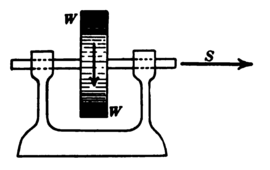| SOME PRACTICAL ASPECTS OF GYROSTATIC ACTION |
By Professor W. S. FRANKLIN
LEHIGH UNIVERSITY
THE Brennan monorail car and the Schlick device for the prevention of rolling of ships at sea have recently attracted popular attention to the gyrostat, and gyrostatic action has recently become vitally interesting to a large group of men because an automobile-engine fly-wheel shows serious gyrostatic reactions when the automobile rounds a curve rapidly or rises suddenly upon a bump in the road. The following discussion will therefore be welcomed by many readers. Let no one imagine that gyrostatic action is mysterious and difficult to analyze; it is really quite simple[1] and the discussion of Fig. 10 makes this action as clear, physically, as the simple inertia reaction of a heavily loaded wagon or boat. The formula for calculating the numerical value of the torque reaction of a gyrostat, as given at the end of this paper, is simple enough for any one to use.
The rotation of a wheel on an axis is called spin, and the axle upon which the wheel rotates is called the axle of spin. The spin of a wheel may be completely represented in both magnitude and  Fig. 1. direction by an arrow drawn parallel to the axle of spin, pointing in the direction in which a right-handed screw would travel if turned with the spinning wheel, and having a length which represents the number of revolutions per second of the wheel. Thus, the arrow S[2] Fig. 1, represents the spin of the wheel WW. Let the arrow S', Fig. 2, represent the spin of a body, imagine a large turning force to act upon the body for a short time, and let the arrow S" represent the spin which would be produced by the turning force if the body had been initially at rest. The actual resultant spin
Fig. 1. direction by an arrow drawn parallel to the axle of spin, pointing in the direction in which a right-handed screw would travel if turned with the spinning wheel, and having a length which represents the number of revolutions per second of the wheel. Thus, the arrow S[2] Fig. 1, represents the spin of the wheel WW. Let the arrow S', Fig. 2, represent the spin of a body, imagine a large turning force to act upon the body for a short time, and let the arrow S" represent the spin which would be produced by the turning force if the body had been initially at rest. The actual resultant spin
- ↑ When the angular velocity of precession is small as compared with the velocity of spin and when the gyrostat wheel is symmetrical with respect to its axis of spin.
- ↑ To appreciate the geometrical meaning of the arrows S, ΔS and T in the vector diagrams given in this paper, the reader should thrust his hand in the direction of the arrow head and move the hand as if turning a right-handed screw.
